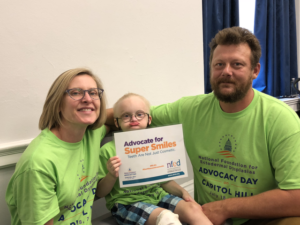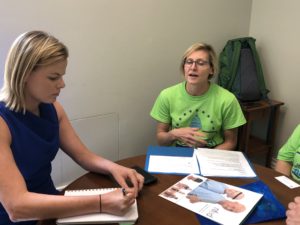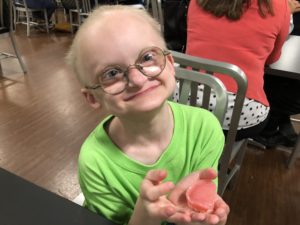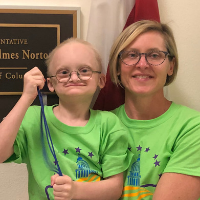By Christine Gottschalk
Sharing our stories with local press is a powerful tool to raise awareness about ectodermal dysplasias and the challenges many of us face getting the health insurance coverage we need. Press helps get the attention of our legislators and will help get the Ensuring Lasting Smiles Act (ELSA) passed.
Have No Fear
Reaching out to the press can seem intimidating, but with a little preparation it doesn’t have to be. It can be empowering. After all, no one knows what we need better than we do. Local media are always looking for human interest stories from within the community, and issues with healthcare and health insurance are relatable.
Big or small almost every family in the United States has had to deal with some health insurance issue for themselves or a loved one. Your story and your legislators’ actions are important and relevant to the whole community.

Act at the 2018 Day On the Hill.
Use Your Voice
Reaching out to journalists around an event is especially effective. For example, you can use a recent meeting with one of your representatives or your recent travel to Washington, D.C. for Day on the Hill to meet with legislators on the Enusring Lasting Smiles Act (ELSA) foas a hook. It is also a wonderful way to recognize and publicly thank legislators who have endorsed ELSA.
What do I say? Don’t worry about having the perfect words. The most important thing is to tell your story in your voice. That’s what people want to hear and that’s what will make people understand why ELSA is important for you and others.

The 5 W’s of Advocacy and Journalism
To prepare to reach out, you should consider answering who, what, where, when, why, and how to tell your story. For me, that looks like the following.
- Who – My son is my why.
- What – Is affected by ectodermal dysplasia, a rare genetic disorder that affects his ability to properly develop teeth, sweat glands and hair. His teeth are completely absent and this severely impacts his ability to chew, swallow and properly digest food. It also impacts his speech and self-esteem.
- When – He was diagnosed at around 18 months old after not developing any teeth. He’s now five and has his first set of dentures. He’ll need extensive and complex medical and dental care to restore normal function over his lifetime.
- Where – We live in Washington, D.C. and drive several hours out of state for specialized care.
- Why – Our insurance auto-denies the medical coverage for anything related to the mouth and teeth. We cover these medical expenses out of pocket. This means tough trade-offs for our family and others like us. Our insurance would provide coverage if the same care was needed as a result of an accident or illness that happened after birth. This happens even with state statues that mandate medical benefits to people born with a congenital anomaly and missing or defective body parts.
- How – ELSA will close this loophole and ensure that health plans cover the complex oral restorative care families like mine need. The legislation is not disease-specific and will help any family with a congenital anomaly struggling to get the healthcare they need.

Where to Begin
I’ve never contacted the press, so where do I start? It’s easier than you might think.
- Ask friends if they know anyone at a local TV or radio station and if they would connect you.
- Ask your legislator, especially if you recently met and they expressed interest in supporting ELSA. They would probably like the positive press.
- Ask your pastor if you are a member of a church or other religious or community group.
- Talk to the press at your legislator’s town hall, quickly pitch your story and why you’re there.
- Google your local news team and reach out to the “health” reporter.

Go Viral
As for social media, posting and sharing news clips on Twitter and Facebook are great ways to amplify stories about ELSA. Even posting a picture with your legislator or their staff noting why you met with them raises awareness and is usually very well received by legislators.
Need more motivation? Check out the following clips from other National Foundation for Ectodermal Dysplasias members. Together, we can get ELSA passed.
If you’ve reached out to press about ELSA, please share your experiences in the comments below.
Christine Gottschalk is a guest blogger for the National Foundation for Ectodermal Dysplasias. She is the mother of a son who is affected by ectodermal dysplasia and an advocacy state lead for Washington D.C.
